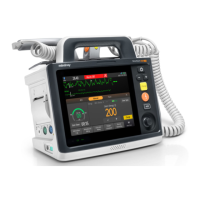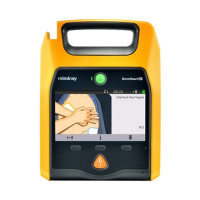A - 18
PR from Nellcor SpO
2
Module
A.8.6 NIBP Specifications
Accuracy ±3 bpm (measured without motion)
±5 bpm (measured with motion)
Refreshing rate ≤1 s
Measurement range 20 to 300 bpm
Resolution 1 bpm
Response time ≤30 s (normal perfusion, no disturbance, PR value sudden change from 25
to 250 bpm)
Accuracy 20 to 250 bpm: ±3 bpm
251 to 300 bpm: not specified
Refreshing rate ≤1 s
Standards Meet standard of IEC 80601-2-30
Technique Oscillometry
Mode of operation Manual, Auto, STAT, Sequence
Auto mode repetition intervals 1 min, 2 min, 2.5 min, 3 min, 5 min, 10 min, 15 min, 20 min, 30 min, 1 h, 1.5 h,
2 h, 3 h, 4 h, 8 h
STAT mode cycle time 5 min
Maximum measurement time Adult, pediatric:
Neonate:
180s
90s
Measurement range Measurement Item Adult Pediatric Neonate
Systolic (mmHg) 25 to 290 25 to 240 25 to 140
Diastolic (mmHg) 10 to 250 10 to 200 10 to 115
Mean (mmHg) 15 to 260 15 to 215 15 to 125
Measurement accuracy* Max mean error: ±5 mmHg
Max standard deviation: 8 mmHg
Static pressure measurement range 0mmHg to 300mmHg
Static pressure measurement accuracy ±3mmHg
Resolution 1 mmHg
Software overpressure protection Adult:
Pediatric:
Neonate:
297±3 mmHg
297±3 mmHg
147±3 mmHg
Initial cuff inflation pressure range Adult:
Pediatric:
Neonate:
80 to 280 mmHg
80 to 210 mmHg
60 to 140 mmHg
*Measurement accuracy verification: In adult and pediatric modes, the blood pressure measurements measured with this
device are in compliance with the Standard for Non-invasive sphygmomanometers (ISO 81060-2)in terms of mean error
and stardard deviation by comparing with intra-arterial or auscultatory measurements (depending on the configuration) in
a typical patient population. For auscultatory reference, the 5th Korotkoff sound was used to determine the diastolic
pressure.
In neonatal mode, the blood pressure measurements measured with this device are in compliance with the American
National Standard for Non-invasive sphygmomanometers (ISO 81060-2) in terms of mean error and standard deviation by
comparing with intra-arterial measurements (depending on the configuration) in a typical patient population.
PR

